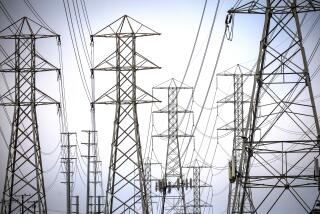Ruling Resurrects Issue of SDG&E;’s Competitiveness
The preliminary recommendation last week against Southern California Edison’s proposed merger with San Diego Gas & Electric focuses attention on SDG&E;’s future as an independent, stand-alone utility if the merger isn’t completed.
If the Public Utilities Commission follows the administrative law judges’ recommendation and prohibits the utilities from merging, SDG&E; would have to look elsewhere for a source for 1,000 megawatts of additional power that it will need by 2000 to meet increased customer demand.
SDG&E; most likely would have to build new power plants, sign long-term contracts to purchase electrical power from other utilities or acquire generating facilities owned by a handful of financially troubled utilities.
Each option would probably produce higher rates for San Diegans, SDG&E; Chairman Tom Page said during a Feb. 1 interview. “Rates would head right back up. . . . We’d be right back in the soup again,” he said, referring to SDG&E;’s recent history as a high-cost utility.
SDG&E; and its customers face “a number of very hard years” if the merger doesn’t go through, said Michael Shames, executive director of Utility Consumers Action Network, a San Diego-based consumer group that has opposed the merger. “Rates could go up dramatically.”
“In the short term, SDG&E; would be a very weakened and depleted company that would have to be rebuilt,” Shames said. “They’ve lost a lot of good people, and morale has been suffering for a prolonged period of time.”
But Shames maintains that future electric rates in San Diego would rise faster and higher if the merger were completed. And, he argues, “SDG&E; should not let this merger drag out any longer” because prompt action could put a cap on future electric rate hikes.
SDG&E; has insulated its customers from dramatic electric rate increases over the next three to five years, even if the merger isn’t completed, Shames said. That insulation comes in the form of contracts that SDG&E; has signed to purchase low-cost electricity from utilities with surplus generating capacity.
But SDG&E;’s longer-term prospects are uncertain if it doesn’t move quickly to arrange a number of short- and long-term power purchase options, Shames said.
“If SDG&E; is not properly positioned, we’ll have the highest rates in the state,” Shames said. “We’ll be returned to the inglorious days of the early 1980s,” when SDG&E; regularly was one of the nation’s highest-cost energy suppliers.
Although Shames describes a utility with severely demoralized employees, Page sees a company that just recorded an “absolute record year” when measured by net income. Page also crows about SDG&E;’s “low rates and high levels of service.”
Page acknowledged that uncertainty created by the lengthy merger reviews “has been a real imposition on . . . our employees. They’ve put up with a lot of grief for an extended period of time.”
But although ongoing federal and state regulatory reviews have generated an extra layer of work, Page said, only a handful of employees have been assigned merger-related duties. Most of the utility’s 4,200 employees have concentrated on day-to-day operations and long-term planning needed to keep the utility functioning should the merger not be completed, he added.
The 1,300-page recommendation issued Friday by two PUC officials found that the merger would produce $1 billion in cost savings that could be used to reduce electric rates. But the judges also argued that the merger was unacceptable because it would lessen competition among the state’s remaining utilities.
SDG&E; executives have maintained that the merger makes sense because Rosemead-based Edison has relatively inexpensive excess power while SDG&E; will need an estimated 1,000 additional megawatts to meet growing customer demand by the year 2000.
One possible scenario that could unfold if the merger is not completed involves Tucson Electric Power, a power-rich but financially troubled Arizona utility that, according to industry analysts, is nearing bankruptcy.
SDG&E; and Tucson Electric abandoned a proposed merger in 1988, shortly after Edison made its own bid to merge with SDG&E.; “We are the best listeners in the West,” said Page, when asked if SDG&E; might be interested in acquiring parts of Tucson Electric if the merger with Edison fails. “It might be to their advantage” to consider the sale of excess electrical generating plants.
SDG&E;’s stock on Monday closed down $1.375 at $42.75, with 280,500 shares traded on the New York Stock Exchange. SCEcorp, Edison’s parent company, closed up $.625 at $37.75, with 329,000 shares changing hands.
Utility industry analysts said the relatively slight volume indicated that shareholders are uncertain about how much of a roadblock the administrative law judges’ recommendation will present. “The stock vacillated all day,” said Edward J. Tirello Jr., a New York-based analyst with Smith Barney, Harris Upham. “And you’d think if people were really concerned, millions of shares would have been traded.”
More to Read
Inside the business of entertainment
The Wide Shot brings you news, analysis and insights on everything from streaming wars to production — and what it all means for the future.
You may occasionally receive promotional content from the Los Angeles Times.










